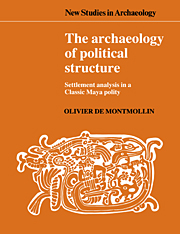Book contents
- Frontmatter
- Contents
- List of figures
- List of tables
- Preface
- 1 Studying ancient complex polities
- 2 Thinking about Maya political structure
- 3 The Rosario polity
- 4 Linking Maya politics and settlement
- 5 Centralization
- 6 Differentiation and integration
- 7 Political regimes and microcosms
- 8 Political stratification patterns
- 9 Mechanical versus organic solidarity
- 10 Segmenting versus non-segmenting organization
- 11 Archaeological study of Maya polities
- Notes
- References
- Index
6 - Differentiation and integration
Published online by Cambridge University Press: 29 March 2010
- Frontmatter
- Contents
- List of figures
- List of tables
- Preface
- 1 Studying ancient complex polities
- 2 Thinking about Maya political structure
- 3 The Rosario polity
- 4 Linking Maya politics and settlement
- 5 Centralization
- 6 Differentiation and integration
- 7 Political regimes and microcosms
- 8 Political stratification patterns
- 9 Mechanical versus organic solidarity
- 10 Segmenting versus non-segmenting organization
- 11 Archaeological study of Maya polities
- Notes
- References
- Index
Summary
Differentiation
Degrees of replication in settlement patterns among the Rosario polity's centers and districts provide insights into degrees of differentiation (along the second subcontinuum contained in the segmentary-unitary continuum. Table 1). Presence or absence of replication (for centers and districts) is judged with reference to values arrived at on the various centralization measures (forced settlement, TDI, and TLI – Figure 15). Other available measures (for districts) are: territorial size, settlement density (and environmental composition), and tributary base size (TBS – Figure 15). A high degree of (horizontal) replication in centralization measures among all hierarchically equivalent units indicates a segmentary polity. Vertical replication of centralization measures across levels of a hierarchy (the PH) indicates segmentary structure, as does increasing degrees of centralization down the PH. Decreasing degrees of centralization down the PH indicate unitary structure. To a very great extent, the differentiation subcontinuum has an analytically residual quality with reference to the centralization subcontinuum. Many of the values examined with reference to differentiation have been generated while investigating centralization (Chapter 5).
At the outset, it appeared that a search for replication in internal layout and composition among sites (and wards) might be a useful way of examining degrees of differentiation in the Rosario polity (de Montmollin 1982a), but it soon turned out that this kind of analysis was inappropriate. Sites are too numerous and richly variable in their internal layout and composition to be effectively compared. Besides practical difficulties of too much detail, there are theoretical objections to the site scale.
- Type
- Chapter
- Information
- The Archaeology of Political StructureSettlement Analysis in a Classic Maya Polity, pp. 116 - 139Publisher: Cambridge University PressPrint publication year: 1989



